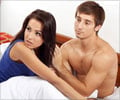While more and more adults are enrolling their kids into abstinence-only programs to keep in check their sexual activities, a new study has revealed that the term 'abstinence' holds
A new study has revealed that the term 'abstinence' holds different meaning to teens and adults, even as more parents are enrolling their kids into abstinence programs.
Researchers at the University of Washington say that this difference in opinion is the main reason behind abstinence-only programs not having strong effects in preventing teenage sexual activity."Interventions that have been created to encourage abstinence have treated abstinence and sexual activity as opposites. However, teenagers say they don't think of them as opposites. These interventions are less likely to work than more comprehensive sex-education programs because they are not meeting adolescents where they are, and they are speaking a different language," said Tatiana Masters, lead author of a new study and UW doctoral student in social work.
This research indicated that attitudes and intentions about sex were more powerful than attitudes and intentions about being abstinent.
"This paper demonstrates that increasing abstinence intention does not lead to less sex. In fact, when abstinence intention and sex intention interact with each other a teenager is more likely to have sex," said Masters.
She said that Instead of being an either or choice, a teenager's decision to become sexually active is similar to getting on an escalator. Initially teenagers don't think about sex very much, and once they step on the escalator the first step is abstinence. Later, as they begin to be sexually aware, there are other steps and choices to be made that eventually lead to having intercourse.
The study was conducted on 365 adolescents, 230 girls and 135 boys, recruited from community centers, youth programs and after-school programs for a larger research project testing an intervention to reduce HIV risk behaviour among young teenagers in Seattle.
Advertisement
In the beginning, it was found that 11 percent of the boys and 4 percent of the girls had had sexual intercourse. The numbers then increased to 12 percent of the boys and 8 percent of the girls six months later and 22 percent of the boys and 12 percent of the girls one year later.
Advertisement
Masters added: "The United States has the highest teen pregnancy rate among developing nations, and rates of sexually transmitted diseases in this country are high. The risks are real, and if people want to keep teens safe from the negative outcomes of sex, abstinence-only programs are not the way to go. More comprehensive programs that include abstinence as one choice are much more likely to have the outcomes we want - that teenagers eventually will be in a positive and fulfilling sexual relationship."
She also said the study was not an evaluation of abstinence-only programs, noting that others studies have shown they don't have an effect on delaying sexual activity. Part of the problem is the way abstinence is taught.
"Abstinence-only programs often only look at the negatives of sex, not the positive. This is especially important for young women who need to have control over having sex and having safe sex. With these programs you often hear 'sex just happens' and adolescents are having less safe sex. This detracts from adolescents having a choice, and this leads to more dangerous sex with more sexually transmitted diseases and pregnancies," said Masters.
Source-ANI
RAS/M









